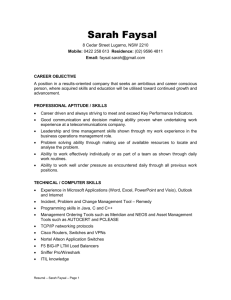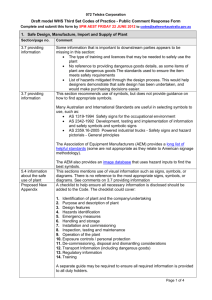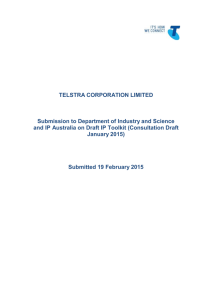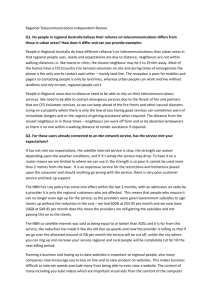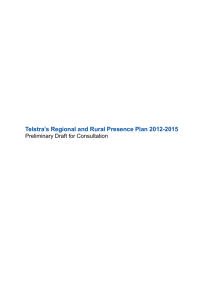Australian Telecom Cisco Lecture Series
advertisement
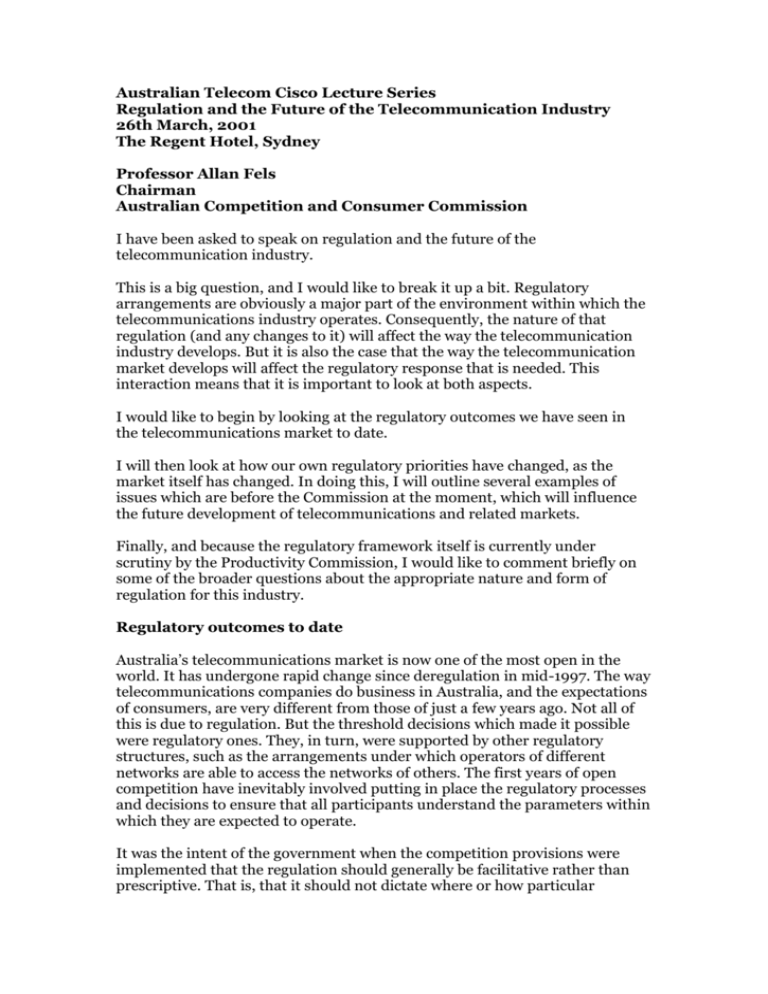
Australian Telecom Cisco Lecture Series Regulation and the Future of the Telecommunication Industry 26th March, 2001 The Regent Hotel, Sydney Professor Allan Fels Chairman Australian Competition and Consumer Commission I have been asked to speak on regulation and the future of the telecommunication industry. This is a big question, and I would like to break it up a bit. Regulatory arrangements are obviously a major part of the environment within which the telecommunications industry operates. Consequently, the nature of that regulation (and any changes to it) will affect the way the telecommunication industry develops. But it is also the case that the way the telecommunication market develops will affect the regulatory response that is needed. This interaction means that it is important to look at both aspects. I would like to begin by looking at the regulatory outcomes we have seen in the telecommunications market to date. I will then look at how our own regulatory priorities have changed, as the market itself has changed. In doing this, I will outline several examples of issues which are before the Commission at the moment, which will influence the future development of telecommunications and related markets. Finally, and because the regulatory framework itself is currently under scrutiny by the Productivity Commission, I would like to comment briefly on some of the broader questions about the appropriate nature and form of regulation for this industry. Regulatory outcomes to date Australia’s telecommunications market is now one of the most open in the world. It has undergone rapid change since deregulation in mid-1997. The way telecommunications companies do business in Australia, and the expectations of consumers, are very different from those of just a few years ago. Not all of this is due to regulation. But the threshold decisions which made it possible were regulatory ones. They, in turn, were supported by other regulatory structures, such as the arrangements under which operators of different networks are able to access the networks of others. The first years of open competition have inevitably involved putting in place the regulatory processes and decisions to ensure that all participants understand the parameters within which they are expected to operate. It was the intent of the government when the competition provisions were implemented that the regulation should generally be facilitative rather than prescriptive. That is, that it should not dictate where or how particular companies do business, but instead provide the environment in which businesses can enter the market, seek opportunities to offer and differentiate their services, take risks they judge acceptable and so bring a competitive dynamic to the market. This was expressed in provisions ensuring that operators could access particular input services, connect to each other’s networks and achieve swift sanctions in the case of anti-competitive conduct. These were important in an environment where the longest-established incumbent operator, Telstra, had market power in most basic telecommunications services and a number of emerging services. Let me state the Commission’s responsibilities here. The legislation requires the Commission to promote the long-term interests of end-users, having regard to the effect on competition, efficient infrastructure investment, efficient use of infrastructure and the achievement of any-to-any connectivity. It also empowers the Commission to act swiftly against instances of anticompetitive conduct. People’s perceptions of how well this has worked inevitably reflect their expectations of the regulatory process in the first place. Those who expected Telstra’s market power in all areas to be quickly eroded are likely to have been disappointed. Telstra now faces competition in most areas of its business, including almost all its retail areas, but retains control over the local loop, giving it virtual monopoly over the critical element of consumer access. This has given rise to a lot of disputation concerning terms and conditions of access to wholesale services. Some also seem to have expected Telstra’s profits to have been quickly eroded. They regard profitability as an indicator of regulatory failure. However, the existence or otherwise of profits does not by itself signify efficiency or the lack of it. The question is how large the profits are relative to the capital and risks associated with new investment, how they are derived and how they are dispersed. In fact, the realities of the situation are more encouraging. Telstra does still have market power in critical areas of the market, but this is largely due to the nature of the infrastructure it commands. Much of that infrastructure – and particularly the local loop – still exhibits some natural monopoly characteristics. In these circumstances, the breakdown of market power through the development of alternative facilities is unlikely to be economically efficient. Instead, what is required is reasonable access to the infrastructure by potential competitors in downstream markets, so that Telstra’s market power cannot be exploited in a way which disadvantages competitors and consumers. The regulation enables this to happen. Under the Telecommunications Access Regime in Part XIC of the Trade Practices Act, the Commission’s ability to ‘declare’ services ensures that those services are made available to access seekers on reasonable terms and conditions. In its role as arbitrator, the Commission resolves disputes concerning the terms and conditions of access. The Commission’s approach to pricing for infrastructure access is generally based on what we calculate, from Telstra’s own accounting and network information and other material available to us, to be the efficient costs of provision. We are still working through the details of some of our pricing principles, but we believe that, for basic fixed line access services, the principle of pricing based on forward-looking efficient costs is right. So do most other regulators in industrialised countries. On the question of profits, a look at Telstra’s most recent results is illuminating. Telstra has just announced a profit increase of over 5 per cent in the second half of the calendar year 2000 over the first-half results. This reflected significant traffic growth in a number of services, as well as a reduction in customer loss and improvements in cost control. Traffic growth in telecommunications tends to raise revenue faster than costs, as many costs are fixed in nature. The revenue growth was greatest in non-basic services (mobiles, data, text and Internet access), and in wholesale and intercarrier services. It does not seem to me that these profits support Telstra’s view, expressed in a number of forums over the last year or so, that the regulatory regime is stifling its incentives to invest and maintain its infrastructure. The returns are clearly there. Not unnaturally, Telstra is concerned to see regulatory changes made which will enable it to retain them. It is not the Commission’s job to regulate Telstra’s profits or control excess profits. My own view is that, as long as genuine competitive forces are at work in the industry, excessive profits cannot be sustained. While they persist, they are an incentive to others to enter the market. The Commission’s role is to ensure that such competition can emerge and flourish, and that access charges are efficient. A level of disappointment has also been expressed by many in the industry – and by the Commission itself – about the level of disputation concerning terms and conditions of access and delays in resolving those disputes through the arbitral process. We have made reference to the causes of these delays, and suggested some solutions, in our submissions to the current Productivity Commission review. However, the issue arises again with Telstra’s appeal against an ACCC arbitration decision. It seems likely that the Tribunal’s decision will not be handed down until 2002. The United States regime is often criticised for being excessively litigious, but here in Australia we appear to have the even more difficult problem that basic decisions made by regulators can be reviewed from scratch, with all the further delays and uncertainty which that implies. Changing regulatory priorities As many of the regulatory arrangements for basic PSTN services are now in place, or even (as in the case of intercapital transmission capacity) being reduced or removed where competition is judged effective, the Commission’s priorities are changing. They are moving to newer services where competition issues are arising, and to more light-handed forms of regulation. I mentioned earlier the objectives specified in the legislation which the Commission implements – to promote the long-term interests of end-users, having regard to the effect on competition, efficient infrastructure use and investment, and the achievement of any-to-any connectivity. In an environment where industry structure, consumer demand and infrastructure are changing, achieving these objectives can mean changing the focus of the regulatory approach in response to changing conditions. I have said on a number of occasions that I believe we still have a considerable way to go in this industry. Telstra retains control over the customer access network for all but a tiny proportion of residential customers in Australia, and prices are still well above costs for some services. In other services, oligopolistic market structures are emerging. In both cases, the opportunity and the incentive to exploit market power against the general community interest may arise. Strong access and anti-competitive conduct regulation will be required in order to protect and enhance the competitive environment where facilitiesbased competition is emerging only slowly or in limited areas. Technologies The rollout of new telecommunications services and infrastructure in Australia has been one of the most important drivers of new competitive forces in the market. New investment has been the vehicle by which new costreducing technologies and new services are being introduced to the market, and generally produces the most effective forms of new competition. However, much of the new infrastructure has been concentrated in the more denselypopulated metropolitan and regional areas. It has also been slowed recently by developments in the financial market and the uncertainty surrounding the future role and structure of C&W Optus. These new technologies offer broadband and wireless capabilities which extend well beyond the provision of telecommunications services alone. They are increasingly being used to provide comprehensive service packages to household consumers, including pay television, telecommunications and data and Internet services, and a range of business-to-business applications. In the process, they are creating new products, new sources of supply, new means of distribution and greater efficiency. I am sometimes asked if competition and consumer protection law will one day become unnecessary as a result of such developments. My answer is ‘no’. As long as there is the opportunity and the incentive for businesses to increase their profits by engaging in forms of anti-competitive behaviour, these developments will merely change the nature of consumer and competition problems, not eliminate them. However, our responses must adapt to recognise that the new forces at work in the economy are lessening the need for application of competition and consumer protection in some areas, while increasing it in others. Let me outline some examples. Mobile phone services Mobile phone services in Australia are provided by three major network operators and two smaller, still-developing networks. The market is continuing to expand rapidly. Consequently, the regulatory arrangements must reflect the greater retail competitiveness and changing cost characteristics in the sector compared with the fixed-line sector. GSM origination and termination services are ‘declared’ services under Part XIC of the Trade Practices Act. However, the determination of terms and conditions of access to those services remains the subject of some discussion. The Commission recently released a draft report on the determination of termination charges for calls to mobile phones. The release was in response to several (ongoing) arbitrations between mobile carriers and fixed carriers wanting to supply retail services. Fixed carriers had been seeking arbitrations from the ACCC to reduce the price of mobile termination and hence fixed-tomobile calls, and suggested that cost-based regulation was required. In reply, the mobile carriers submitted that the industry was increasingly dynamic and competitive and that the Commission should not get involved. They argued that retail charges had fallen in recent years, and that regulatory intervention might adversely affect investment in the industry (including the 3G spectrum auctions currently underway). The Commission sought to establish whether the industry was delivering efficient outcomes. It received advice indicating that, although there are multiple suppliers of the mobile (GSM) termination service, mobile carriers retain market power in relation to access to their own customers, and that normal market constraints are avoided because consumers receiving mobile calls are not generally aware of the charges levied by their carrier for terminating those calls. It also found that the price of terminating calls on mobile networks in Australia remains high relative to cost, resulting in higher retail charges than would otherwise be possible. It concluded that some regulation of these charges was warranted. This is not just an Australian phenomenon. Other regulators are also exploring similar questions. The UK regulator, Oftel, for example, is conducting a review on mobile termination charges at present. Nevertheless, the Commission reached the draft view that ‘heavy-handed’ regulation is not appropriate in such a dynamic industry. Cost-based pricing, while generally preferred as a pricing rule by the Commission, is better suited to well-developed and less dynamic services. Consequently, the Commission proposed in its draft report to ‘benchmark’ or tie changes in retail prices to wholesale termination charges. The approach has the advantages of linking more competitive (retail) outcomes with less competitive (wholesale) outcomes and allowing carriers to retain some pricing flexibility. This approach relies on the overall competitiveness of the market to drive changes, while ensuring that the benefits of that competition are not focused on retail mobile customers at the expense of fixed-to-mobile customers. It is also a more light-handed approach. The Commission proposed to review the approach in two years time. Broadband access Broadband infrastructure is of particular and growing importance to the future of all digital services, and Australia, along with other countries, is progressively developing its broadband infrastructure networks. These include fixed networks like broadband cable and various radio-based technologies of both the stationary and mobile type, such as LMDS, satellite and prospective 3rd Generation mobile technologies. However, it is the potential to utilise the existing telephony copper network, a network that passes almost every Australian household, to deliver high speed Internet access which opens the possibility of achieving high levels of broadband penetration in the residential space. Digital subscriber line (DSL) technologies utilising the unconditioned local loop (ULL) are the vehicle by which this is likely to be achieved. However, the rate and ultimate extent of takeup of such services is clearly dependent on their price, among other things. The Commission is monitoring the pricing of the regulated unconditioned local loop, together with other factors likely to affect the speed at which DSL services can be delivered to a broader audience. Australia was at the forefront of moves around the world to open up hitherto closed monopoly controlled local loops when the Commission mandated direct access to Telstra’s copper in August 1999. Declaration was expected to influence significantly the development of competition for local telephony services and high bandwidth carriage services and to enhance competition for long distance telephony services, including via ADSL technology. Following the declaration of the unconditioned local loop, the industry undertook the enormous task of developing operational and technical codes to support DSL. However, in mid 2000 as Telstra began preparing to release its retail ADSL services the Commission began to see signs that suggested that competition was, in part, being frustrated by access seekers not being granted timely access to exchanges. The Commission spoke to both access seekers and Telstra about these concerns. We felt that, as Telstra was both a wholesaler and retailer of ADSL services and controlled access to exchanges, it was necessary to make Telstra’s role in the delivery of high-speed data services more transparent. It was also important to gain a commitment from Telstra that it would not launch its retail ADSL products before its competitors had available a wholesale product to ensure competition at the retail level. As a result of those inquiries, the Commission now requires Telstra to provide us with extensive detail on a weekly basis on the way in which Telstra plans to provide access seekers with prompt access to exchanges as well as the scope and timeframes in which it delivers services on the unconditioned local loop to itself and to other access seekers. The Commission is also monitoring some other unresolved issues surrounding ADSL services. These include the differential between Telstra’s wholesale and retail ADSL prices and the identification of costs directly attributable to the unconditioned local loop. Our efforts are intended to increase the penetration of broadband services and we are confident that this will occur. However, it will be progressive rather than immediate. At present, services are still being rolled out and equipment costs are still high. It is probably not surprising that larger users, including corporate customers, are being targeted first. It is also evident that competitors are facing a more severe financial environment and mass-market applications are still evolving. Nonetheless, the Commission’s efforts to improve the processes of ULL and ADSL provision, including further scrutinising the pricing of these services, along with wider applications for the services, should see a progressively greater takeup by residential consumers over time. Cable broadband networks I would also like to say something about the Commission’s approach to the regulation of cable broadband networks. The Commission has mandated access to cable (HFC) networks to enable service providers to deliver analogue pay TV services in competition to those already provided by Foxtel and Optus. However, the Commission has so far refrained from regulating access to HFC and satellite networks for the delivery of digital Pay TV or any other digital services. When it last looked at this matter, in 1999, the Commission considered that there was too much uncertainty about the emerging digital environment to conclude that regulation was necessary to promote the long-term interests of end users, but that it would keep this under review. There has been some speculation recently, with rumours of the impending digitisation of the Telstra and Optus HFC cable networks, about whether the Commission would or should revisit this issue and make a more definitive decision about the need for regulation of digital services. Some parties have also expressed concern that the possibility of regulation of these networks may be acting as a brake on investment to digitise these networks. The Commission believes that it is in the interests of both service providers and customers for broadband platforms to be open rather than closed. An open access environment ensures the competitive provision of services and can also mean a more efficient and more effective use of broadband networks. An open access environment is one characterised by non-discriminatory access, that is, where the owners of digital platforms provide access to service providers on similar terms and conditions as those provided to their own internal service providers. However, the effectiveness of such a regime will depend on its acceptance by the parties involved. An open access environment is likely to be well-received by infrastructure owners, but the Commission’s experience with existing cable regulation shows that access can be frustrated for long periods by access providers. Telstra and Foxtel have engaged in a lengthy campaign to prevent access to HFC cable networks for the analogue pay TV services and slow down related processes, and are clearly able to devote considerable energy and resources to such activities. The case for regulation of other access platforms, however, is not as clear-cut. For example, unlike the copper network, digital platforms are likely to be characterised by greater degrees of competition and new entry over time. Digital networks will have enormous carrying capacity – for example, digital cable networks are expected to have nearly ten times the capacity of that currently available on analogue Pay TV networks. It is also likely that over time competition between different digital platforms will intensify, providing even greater choices and benefits to consumers. Digital platform providers therefore have a choice. They can take the early initiative in opening up their networks for digital services, thereby creating significant opportunities and benefits for both themselves and their customers or they can take the regressive step of maintaining closed shops - and then facing the diversity of demands from service providers, governments and customers for regulatory intervention. In the Commission’s view, regulation of other digital platforms will only need to be considered where commercial forces are being deliberately undermined and where the objective of an open access environment is being stifled. Legitimate market drivers should be given the opportunity to do their job. The regulatory framework The regulatory framework itself is currently under review. Indeed, the Productivity Commission will release later this week the draft report of its current review of the telecommunications-specific competition provisions in the Trade Practices Act and other regulation. The review team has been considering issues as fundamental as whether industry-specific regulation should be retained for telecommunications and, if so, in what form. The Commission has expressed its views on these matters to the Productivity Commission in a number of formal submissions. We have drawn on our experience in implementing the provisions over the last four years to indicate where we believe amendments to the provisions would improve the speed and effectiveness with which they operate. Many of these relate to the causes of disputation within the industry and the processes by which disputes are arbitrated by the Commission. More importantly, we have reiterated our conviction that market forces, operating through competitive structures, are the best way of promoting the long-term interests of end-users in this, as in any other, market. However, where industry characteristics and structures prevent the effective operation of competition, we believe that regulation will continue to be required. As I noted previously, both monopolistic and oligopolistic structures are still apparent and are not likely to change quickly. In such an environment, appropriate access and anti-competitive conduct regulation will be required in order to protect and enhance the competitive environment. Like all of you, we are looking forward to examining the outcomes of the Productivity Commission’s deliberations. Conclusion The telecommunications market is still a market in transition. I believe there is still a job to do to ensure that competition can continue to develop and flourish. The future of the telecommunications industry in Australia is about competition. The current regulation establishes the mechanisms for achieving both facilities-based and access-based competition and the efficient balance between them, and for ensuring that anti-competitive conduct is subject to swift sanctions. The Commission has shown that it is prepared to pursue a hard line where it believes that is necessary (as in the case of ADSL rollout), but to adopt more light-handed solutions where those are warranted. The draft principles for the regulation of mobile termination charges are an example of the latter. Similarly, our stance on digital cable services is one of allowing incumbent operators to take the initiative to establish access arrangements which benefit themselves and potential access seekers, rather than to mandate access through regulation. I believe that this flexible, responsive approach will continue to serve well the telecommunications industry and Australians generally.
